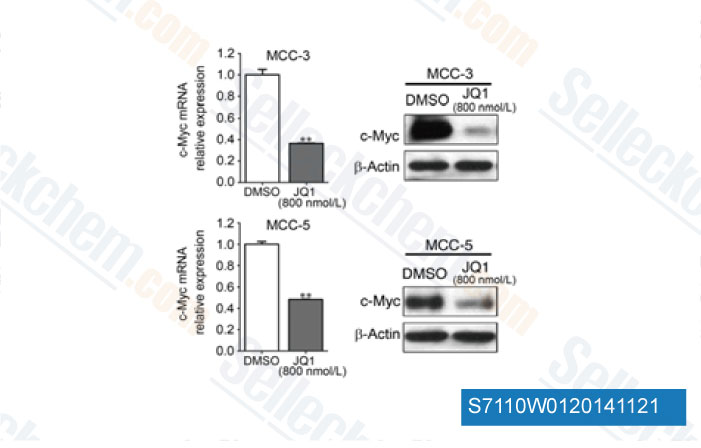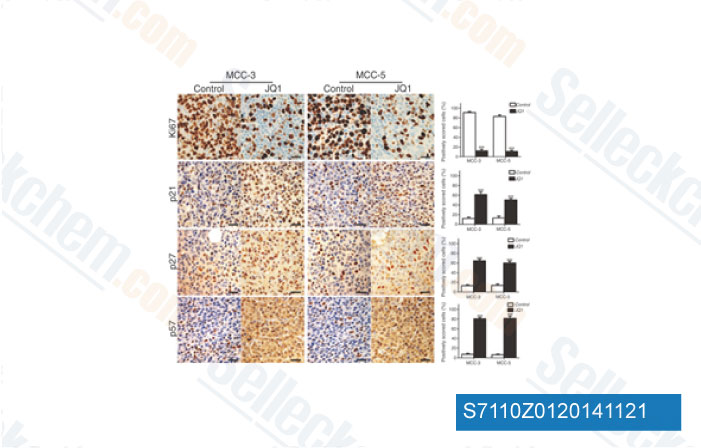|
Toll Free: (877) 796-6397 -- USA and Canada only -- |
Fax: +1-832-582-8590 Orders: +1-832-582-8158 |
Tech Support: +1-832-582-8158 Ext:3 Please provide your Order Number in the email. |
Technical Data
| Formula | C23H25ClN4O2S |
|||
| Molecular Weight | 456.99 | CAS No. | 1268524-70-4 | |
| Solubility (25°C)* | In vitro | DMSO | 91 mg/mL (199.12 mM) | |
| Ethanol | 91 mg/mL (199.12 mM) | |||
| Water | Insoluble | |||
|
* <1 mg/ml means slightly soluble or insoluble. * Please note that Selleck tests the solubility of all compounds in-house, and the actual solubility may differ slightly from published values. This is normal and is due to slight batch-to-batch variations. * Room temperature shipping (Stability testing shows this product can be shipped without any cooling measures.) |
||||
Preparing Stock Solutions
Biological Activity
| Description | (+)-JQ1 is a BET bromodomain inhibitor, with IC50 of 77 nM/33 nM for BRD4(1/2) in cell-free assays, binding to all bromodomains of the BET family, but not to bromodomains outside the BET family. (+)-JQ1 suppresses cell proliferation via inducing autophagy. (+)-JQ1 inhibits the expression of Nuclear receptor binding SET domain protein 3 (NSD3) target genes. | ||||
|---|---|---|---|---|---|
| Targets |
|
||||
| In vitro | (+)-JQ1 enantiomer binds directly into the Kac binding site of BET bromodomains. (+)-JQ1 (500 nM) binds BRD4 competitively with chromatin resulting in differentiation and growth arrest of NMC cells. (+)-JQ1 (500 nM) attenuates rapid proliferation of NMC 797 and Per403 cell lines as demonstrated by reduced Ki67 staining. (+)-JQ1 (500 nM) potently decreases expression of both BRD4 target genes in NMC 797 cells. (+)-JQ1 inhibits cellular viability with IC50 of 4 nM in NMC 11060 cells. [1] (+)-JQ1 results in robust inhibition of MYC expression in MM cell lines. (+)-JQ1 inhibits proliferating of KMS-34 and LR5 with IC50 of 68 nM and 98 nM, respectively. (+)-JQ1 (500 nM)-treated MM.1S cells results in a pronounced decrease in the proportion of cells in S-phase, with a concomitant increase in cells arrested in G0/G1. (+)-JQ1 (500 nM) results in pronounced cellular senescence by beta-galactosidase staining. (+)-JQ1 (800 nM) exposure leads to a significant reduction in cell viability among the majority of CD138+ patient-derived MM samples tested. [2] (+)-JQ1 inhibits growth of LP-1 cells with GI50 of 98 nM. (+)-JQ1 (625 nM) results in an increase in the percentage of LP-1 cells in G0/G1. (+)-JQ1 (500 nM) suppresses the expression of MYC, BRD4 and CDK9 in LP-1 cells. [3] (+)-JQ1 (1 μM) activates HIV transcription in latently infected Jurkat T cells. (+)-JQ1 (50 μM) stimulates predominantly Tat-dependent HIV transcription in both Jurkat and HeLa cells. (+)-JQ1 (5 μM) induces Brd4 dissociation enables Tat to recruit SEC to HIV promoter and induce Pol II CTD phosphorylation and viral transcription in J-Lat A2 cells. JQ1 enables Tat to increase CDK9 T-loop phosphorylation and partially dissociates P-TEFb from 7SK snRNP in Jurkat T cells. [4] | ||||
| In vivo | (+)-JQ1 (50 mg/kg) inhibits tumors growth in mice with NMC 797 xenografts. (+)-JQ1 (50 mg/kg) results in effacement of NUT nuclear speckles in mice with NMC 797 xenografts, consistent with competitive binding to nuclear chromatin. (+)-JQ1 (50 mg/kg) induces strong (grade 31) keratin expression in NMC 797 xenografts. (+)-JQ1 (50 mg/kg) promotes differentiation, tumor regression and prolonged survival in mice models of NMC xenografts. [1] (+)-JQ1 (50 mg/kg) results in a significant prolongation in overall survival of SCID-beige mice orthotopically xenografted after intravenous injection with MM.1S-luc+ cells compared to vehicle-treated animals. [2] (+)-JQ1 (50 mg/kg i.p.) leads to a highly significant increase in survival of mice bearing Raji xenografts. [3] | ||||
| Features | (+)-JQ1 is more effective than (-)-JQ1. |
Protocol (from reference)
| Cell Assay: |
|
|---|---|
| Animal Study: |
|
References
Customer Product Validation

-
Data from [Cancer Res, 2014, 74(23), 7090-102]

-
Data from [Cancer Res, 2014, 74(23), 7090-102]
-JQ1-S711001Y0120170215.gif)
-
Data from [Data independently produced by , , Sci Rep, 2016, 6:23770.]
-JQ1-S711001Z0520170215.gif)
-
Data from [Data independently produced by , , Oncotarget, 2016, 6(7):5134-46.]
Selleck's (+)-JQ1 has been cited by 441 publications
| MYC ecDNA promotes intratumour heterogeneity and plasticity in PDAC [ Nature, 2025, 10.1038/s41586-025-08721-9] | PubMed: 40074906 |
| Super-enhancer-driven EFNA1 fuels tumor progression in cervical cancer via the FOSL2-Src/AKT/STAT3 axis [ J Clin Invest, 2025, e177599] | PubMed: 39964764 |
| GDP-mannose 4,6-dehydratase is a key driver of MYCN-amplified neuroblastoma core fucosylation and tumorigenesis [ Oncogene, 2025, 10.1038/s41388-025-03297-0] | PubMed: 39956863 |
| USP35 promotes the growth of ER positive breast cancer by inhibiting ferroptosis via BRD4-SLC7A11 axis [ Commun Biol, 2025, 8(1):64] | PubMed: 39820080 |
| Targeting Monoallelic CREBBP / EP300 Mutations in Germinal Center-Derived B-Cell Lymphoma with a First-in-Class Histone Acetyltransferase Activator [ bioRxiv, 2025, 2025.03.13.642871] | PubMed: 40161591 |
| Mechanism for controlled assembly of transcriptional condensates by Aire [ Nat Immunol, 2024, 25(9):1580-1592] | PubMed: 39169234 |
| Dual Inhibition of CDK4/6 and XPO1 Induces Senescence With Acquired Vulnerability to CRBN-Based PROTAC Drugs [ Gastroenterology, 2024, S0016-5085(24)00062-3] | PubMed: 38262581 |
| Platelet and Erythrocyte Membranes Coassembled Biomimetic Nanoparticles for Heart Failure Treatment [ ACS Nano, 2024, 18(39):26614-26630] | PubMed: 39174015 |
| C5aR1 inhibition reprograms tumor associated macrophages and reverses PARP inhibitor resistance in breast cancer [ Nat Commun, 2024, 15(1):4485] | PubMed: 38802355 |
| Orthogonal proteogenomic analysis identifies the druggable PA2G4-MYC axis in 3q26 AML [ Nat Commun, 2024, 15(1):4739] | PubMed: 38834613 |
RETURN POLICY
Selleck Chemical’s Unconditional Return Policy ensures a smooth online shopping experience for our customers. If you are in any way unsatisfied with your purchase, you may return any item(s) within 7 days of receiving it. In the event of product quality issues, either protocol related or product related problems, you may return any item(s) within 365 days from the original purchase date. Please follow the instructions below when returning products.
SHIPPING AND STORAGE
Selleck products are transported at room temperature. If you receive the product at room temperature, please rest assured, the Selleck Quality Inspection Department has conducted experiments to verify that the normal temperature placement of one month will not affect the biological activity of powder products. After collecting, please store the product according to the requirements described in the datasheet. Most Selleck products are stable under the recommended conditions.
NOT FOR HUMAN, VETERINARY DIAGNOSTIC OR THERAPEUTIC USE.
